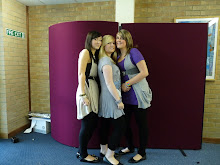Research

- ‘NME’ is a weekly British music magazine.
- Title is short for ‘The Musical Express’.
- Title is always in a bold red font, with a white outline so the audience always recognises the magazine.
- ‘Free Poster’ advert attracts a broader audience.
- Only three colours of text are used; yellow, black and white.
- Magazine includes TV reviews.
- Cover photograph is a medium shot and the models are looking directly into the camera.
-‘Skins’ text is much bolder, so that it stands out and shows it is the main feature.
- Hooks on the cover help to attract a wider audience.
- Bar along the bottom is a common convention of a magazine as it links to other features in the magazine.
- Barcode is subtly placed.Magazine has a teenage target audience.
Contents PagesAfter analysising the magazine covers, I decided to also analyse two contents pages as this would help me to creat my own.
 ‘Q’s contents page uses the following conventions:
‘Q’s contents page uses the following conventions:
- It has a clear well organised layout.
- It is quick and easy to read.
- The text is aligned down one side making it easy to read.
- The same colour scheme is used as on the front cover.
- Only three fonts have been used.
- It has separated the text into three sections: features, the Lennon issue, and every month.
- The close up of James Blunt takes up a lot of the contents page, this implies that he plays a bit part in the months issue.
- He is also looking directly into the camera.
- The bar along the bottom links to other stories in the magazine.
- A white background is used so that all of the text and photographs stand out against it.Main Articles Finally, I decided to analysis magazine articles, as it would help me to gather ideas on how to structure my main article.

-
This article is from 'Word' magazine. - There is no title to the article so this suggests there is a cover page.- White background makes pictures and writing stand out.- Double page spread. - 4 seperate photographs of Madonna have been used, all from the same event. - Other pictures have a white box around them and a drop shadow has been used to make them look like Polaroid photographs. - Not a question and answer interview.- One of her quotes has been enlarged and has been placed in between two columns; this is a common convention of a magazine. - Text is seperated into four columns.- All of the text is in black.- The website is written along the bottom of each page.- Photograph credits are written down the side. Although 'OK' is not a music magazine, I decided I wanted to analyse it as I liked the style of the article. Only three colour fonts have been used; black, white and gold. The interview is with Emma Watson, a famous actress and the reader immediately knows who it is with as her name is written inside of a gold header to make it stand out on the white background. At the beginning of the article there is a block of text that tells us a small amount of information about the actress, this is the introduction to the article. The rest of the article is wrote in a question and answer format, unlike the other pieces. The questions are wrote in a black bold font to make them stand out from the questions. I like this style of article, and I am going to use this format when I create my own magazine.
Although 'OK' is not a music magazine, I decided I wanted to analyse it as I liked the style of the article. Only three colour fonts have been used; black, white and gold. The interview is with Emma Watson, a famous actress and the reader immediately knows who it is with as her name is written inside of a gold header to make it stand out on the white background. At the beginning of the article there is a block of text that tells us a small amount of information about the actress, this is the introduction to the article. The rest of the article is wrote in a question and answer format, unlike the other pieces. The questions are wrote in a black bold font to make them stand out from the questions. I like this style of article, and I am going to use this format when I create my own magazine.
After analysing a range of front covers, contents pages and main articles I am now able to use ideas from those magazines when I create my own. I know now a lot of the conventions of these pieces and I will be able to incorporate them into my own magazine, in order to make it successful.Before I created my magazine, I put a range of fonts onto a page of A4 paper, and asked 100 people what they thought were the most bol d, eye catching fonts.
d, eye catching fonts.
The most popular fonts were
- Eras Bold
- Broadway
- Impact.
After considering a range of factors I decided to choose 'Impact' font as the writing for my title, because I think it is the most bold, eye catching text, out of the three the public selected.












































